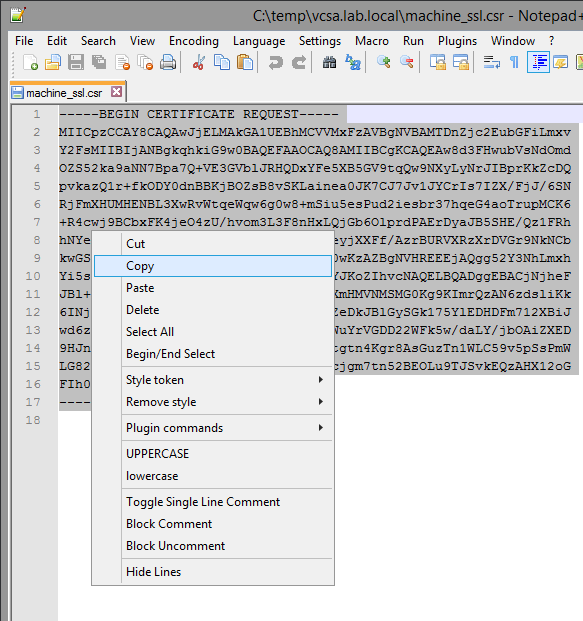Generate Ssl Key From Csr
- Secure and easy Certificate Signing Request generation for your SSL certificates. CSR Generator security github. Generate a Certificate Signing Request. Complete this form to generate a new CSR and private key. Organizational Unit.
- Nov 21, 2019 Above command will generate a private key in the file domain.key and certificate request in the file domain.csr and save it in your current directory. View and copy the contents of private key. You can view and store the private keys on your server that you may need later. However, the important thing is not to share it with anyone.
Jul 09, 2019 Can I generate a new Private Key for my Certificate if I lose the old one? You can generate a new private key and CSR, or use the automatic CSR and key generation during Certificate reissue (this option is available for all Certificates except for the Multi-Domains). What does the Private Key look like? Feb 12, 2015 SSL Certificates fall into two broad categories: 1). In this article, we will demonstrate how to create a CSR (Certificate Signing Request) on a Linux system. Creating a CSR – Certificate Signing Request in Linux. Then issue the following command to generate a CSR and the key that will protect your certificate.
What is a CSR? A CSR or Certificate Signing request is a block of encoded text that is given to a Certificate Authority when applying for an SSL Certificate. It is usually generated on the server where the certificate will be installed and contains information that will be included in the certificate such as the organization name, common name (domain name), locality, and country. It also contains the public key that will be included in the certificate. A private key is usually created at the same time that you create the CSR, making a key pair. A CSR is generally encoded using ASN.1 according to the PKCS #10 specification.
A certificate authority will use a CSR to create your SSL certificate, but it does not need your private key. You need to keep your private key secret. The certificate created with a particular CSR will only work with the private key that was generated with it. So if you lose the private key, the certificate will no longer work.
What is contained in a CSR?
| Name | Explanation | Examples |
|---|---|---|
| Common Name | The fully qualified domain name (FQDN) of your server. This must match exactly what you type in your web browser or you will receive a name mismatch error. | *.google.com |
| Organization | The legal name of your organization. This should not be abbreviated and should include suffixes such as Inc, Corp, or LLC. | Google Inc. |
| Organizational Unit | The division of your organization handling the certificate. | Information Technology IT Department |
| City/Locality | The city where your organization is located. | Mountain View |
| State/County/Region | The state/region where your organization is located. This shouldn't be abbreviated. | California |
| Country | The two-letter ISO code for the country where your organization is location. | US GB |
| Email address | An email address used to contact your organization. | webmaster@google.com |
| Public Key | The public key that will go into the certificate. | The public key is created automatically |
What does a CSR look like?
Most CSRs are created in the Base-64 encoded PEM format. This format includes the '-----BEGIN CERTIFICATE REQUEST-----' and '-----END CERTIFICATE REQUEST-----' lines at the begining and end of the CSR. A PEM format CSR can be opened in a text editor and looks like the following example:
-----BEGIN CERTIFICATE REQUEST-----
MIIByjCCATMCAQAwgYkxCzAJBgNVBAYTAlVTMRMwEQYDVQQIEwpDYWxpZm9ybmlh
MRYwFAYDVQQHEw1Nb3VudGFpbiBWaWV3MRMwEQYDVQQKEwpHb29nbGUgSW5jMR8w
HQYDVQQLExZJbmZvcm1hdGlvbiBUZWNobm9sb2d5MRcwFQYDVQQDEw53d3cuZ29v
Z2xlLmNvbTCBnzANBgkqhkiG9w0BAQEFAAOBjQAwgYkCgYEApZtYJCHJ4VpVXHfV
IlstQTlO4qC03hjX+ZkPyvdYd1Q4+qbAeTwXmCUKYHThVRd5aXSqlPzyIBwieMZr
WFlRQddZ1IzXAlVRDWwAo60KecqeAXnnUK+5fXoTI/UgWshre8tJ+x/TMHaQKR/J
cIWPhqaQhsJuzZbvAdGA80BLxdMCAwEAAaAAMA0GCSqGSIb3DQEBBQUAA4GBAIhl
4PvFq+e7ipARgI5ZM+GZx6mpCz44DTo0JkwfRDf+BtrsaC0q68eTf2XhYOsq4fkH
Q0uA0aVog3f5iJxCa3Hp5gxbJQ6zV6kJ0TEsuaaOhEko9sdpCoPOnRBm2i/XRD2D
6iNh8f8z0ShGsFqjDgFHyF3o+lUyj+UC6H1QW7bn
-----END CERTIFICATE REQUEST-----
How do I generate a CSR and private key?
You need to generate a CSR and private key on the server that the certificate will be used on. You can find instructions in your server documentation or try the instructions from one of these certificate authorities:
Comodo CSR Generation Instructions
DigiCert CSR Generation Instructions
Entrust CSR Generation Instructions
GeoTrust CSR Generation Instructions
Thawte CSR Generation Instructions
Once you have your CSR generated, you can use our SSL Wizard to find the best SSL certificate that will meet your needs. If you are familiar with OpenSSL you can use the following command to generate a CSR and private key:
openssl req -new -newkey rsa:2048 -nodes -out servername.csr -keyout servername.key
How do I decode a CSR?
Generate Private Key From Csr File
You can easily decode your CSR to see what is in it by using our CSR Decoder. In order to decode a CSR on your own machine using OpenSSL, use the following command:
openssl req -in server.csr -noout -text
Ssl Csr Generator

What is a CSR/Private Key's bit length?
The bit-length of a CSR and private key pair determine how easily the key can be cracked using brute force methods. As of 2016, a key size of less than 2048 bits is considered weak and could potentially be broken in a few months or less with enough computing power. If a private key is broken, all the connections initiated with it would be exposed to whomever had the key. The Extended Validation guidelines that SSL certificate providers are required to follow, require that all EV certificates use a 2048-bit key size to ensure their security well into the future. Because of this, most providers encourage 2048-bit keys on all certificates whether they are EV or not.
Generate Ssl Key From Csr Key
Originally posted on Sun Dec 7, 2008